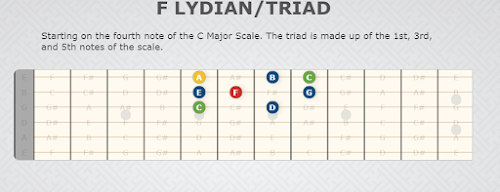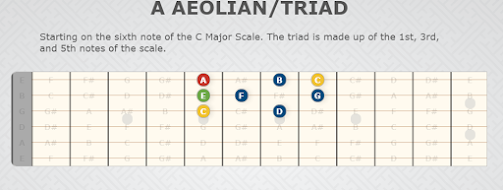Easy Modes from the Major Scale Shape
7 Modes of the Major Scale
Hi all..
I hope this will give everyone an idea of how the different modes sound and also a basis for people who may be starting to get into modes but are unsure where to begin.
In other pieces I have written, I have told you that different modes are made up from the construction from a parent scale. The parent scale we are going to use below is the C major scale.
If you find this article useful, please subscribe, it really helps my blog.
Triads
From Wikipedia:-
In music, a triad is a set of three notes (or "pitch classes") that can be stacked vertically in thirds. The term "harmonic triad" was coined by Johannes Lippius in his Synopsis musicae novae (1612).
When stacked in thirds, notes produce triads. The triad's members, from lowest-pitched tone to highest, are called:-
- the root
- Note: Inversion does not change the root. (The third or fifth can be the lowest note.)
- the third – its interval above the root being a minor third (three semitones) or a major third (four semitones)
- the fifth – its interval above the third being a minor third or a major third, hence its interval above the root being a diminished fifth (six semitones), perfect fifth (seven semitones), or augmented fifth (eight semitones). Perfect fifths are the most commonly used interval above the root in Western classical, popular and traditional music.
How to use the information and also transpose.
Although this is a basic idea to start you off, you will see that this idea works, although it is limiting because of the small area of the fretboard we are working with. Who was it that once said 'a journey of a thousand miles starts with one step'.
If we wish to play a song in a major key happens to be in an Ionian Mode, then we can use the corresponding shape shown above. If the piece is in C, happy days. we already know that shape, it looks like this, remember!!
By highlighting the notes of the triad things are going to sound great because these are the 'target notes' we are looking for with the underlying C Major chord.
What happens if the song we wish to play is in the Ionian mode but... it is in the key of A, or G or F...
Simple, we just take the shape we already know and move the whole thing to the new position. For example, let's take the key of D, and we are going to look at the D Ionian mode. we know the C Ionian shape and triad, it is shown above. To get to the D we must move up two notes to find our root note:-
You should now go and practice these ideas with backing tracks. Here is a link to a webpage that will provide you access to free backing tracks to practice:-
The same is true for all the modes I have mentioned and the shapes. To let yo usee this in actiona again here is the Aeolian Mode in F. Firstly the A Aeolian shape mentioned before
I am not going to insult your intelligence by moving every shape along the neck, I am sure you have the idea.
Final Thoughts.
As I have previously said, this idea is really for a beginner and also for individuals to get an idea of the sould of each mode. I would suggest expanding the corrsponding shape up into the 4th 5th and 6th strings, and also along the fretboard
I do have some recommendations for using each mode which I will pass on to any subscribers.
Thanks for taking the time to read this, feel free to comment.
If you find this article useful, please subscribe, it really helps my blog.


















Comments
Post a Comment